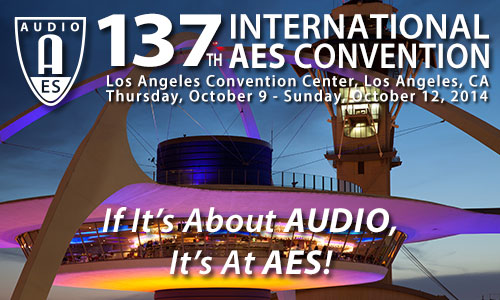
AES Los Angeles 2014
Engineering Brief EB3
EB3 - eBriefs—Papers Session 1
Friday, October 10, 5:00 pm — 6:15 pm (Room 308 AB)
Chair:
Christoph M. Musialik, Sennheiser Audio Labs - Waldshut-Tiengen, Germany
EB3-1 "It Has to Work With the Picture": Audio Education for Film and Media Students—Ufuk Onen, Bilkent University - Ankara, Turkey
Audio education for students who major in filmmaking, video production, visual media practice, or visual communication design in universities' bachelor-degree programs usually starts with creating and improving awareness for sound both in general and, also, in relation to visual media as well. In addition to that, since these students utilize recording and mixing only as a part of their professional practice, not as their main field of specialty, teaching the technical concepts and aesthetics to them requires making use of different content and approach than to those who intend to become audio specialists. This paper discusses these issues by using COMD 361 Sound Design course at Bilkent University, Department of Communication and Design, as a case study.
Engineering Brief 167 (Download now)
EB3-2 Film Production Sound in Secondary Markets—The Value of Networking—Tom Hauser, Hooz Audio - Winston-Salem, NC, USA
I came back home to North Carolina after a negative experience interning in Nashville and eventually navigated my way into sound for picture in corporate and commercial work. I have built my network over several years, gone to grad school for film scoring, moved away from the slightly more competitive area of Raleigh, and now have a small 5.1 mixing studio in Winston-Salem, NC. I want to highlight some of the things a young person needs to know to get work as a new comer among veterans where ever they go, emphasize continual skill development beyond school, the value of personal relationships, and navigating the ups and downs of being a freelancer.
Engineering Brief 168 (Download now)
EB3-3 "Object" Panning for Film: Challenges and Solutions—Ben Loftis, Harrison Consoles - Nashville, TN, USA
Object-based panning allows film mixers to break free of the limits imposed by traditional surround formats. Harrison Consoles has developed software panning that allows sounds to be treated as objects in a 3D space that can then be rendered in various surround formats. This enables users to mix in immersive sound formats and transition to traditional surround formats without having to start a new mix; it was most recently implemented at Sony Pictures for the mix of The Amazing Spider-Man 2. Explained in this paper are the obstacles that we faced, and how we overcame them, making technologies such as Dolby Atmos and Barco Auro3D part of the original mix rather than an afterthought.
Engineering Brief 169 (Download now)
EB3-4 Orchestral Recording and Live Webcasting at McGill University—Alejandro Aspinwall, McGill University - Montreal, QC, Canada; Centre for Interdisciplinary Research in Music Media and Technology (CIRMMT) - Montreal, Quebec, Canada
Recording and broadcasting live audio and video of a large student orchestra performance can be a tremendous challenge but can also be a great educational experience when organized properly. The most important aspects to succeed in this task are assembling a team of students with the adequate technical skills to resolve potential problems and putting together an efficient system that can handle potential problems such as power outages or digital audio workstation failure. This kind of event prepares the students for real life scenarios where they will encounter similar workflows and will be able to spot and prevent technical flaws that could compromise the success of future events. Finally, having a group of students with assigned responsibilities will improve their teamwork skills and allow them to communicate with peers outside their area of expertise.
Engineering Brief 170 (Download now)
EB3-5 Stereo Bluetooth and Low Latency Applications—Jonny McClintock, CSR - Belfast, Northern Ireland, UK
The A2DP Bluetooth protocol is used to transport stereo audio over a non-synchronous packetized structure. Using a frame-based codec, i.e., SBC or AAC, results in system latencies between 150 and 800 milliseconds with wide drifts up to +/– 200ms. A2DP can be used for music but because of the problems associated with the frame-based codecs, Bluetooth is not suitable for audio for video or gaming applications. The aptX codec offers an alternative. It uses a fundamentally different coding architecture and is sample-based
delivering a system latency of 40ms with minimal drift, i.e., +/– 1 ms. With the use of aptX, Bluetooth can now be used to wireless connect TV’s to soundbars, gaming consoles to headsets, and PC’s to speakers.
Engineering Brief 171 (Download now)
